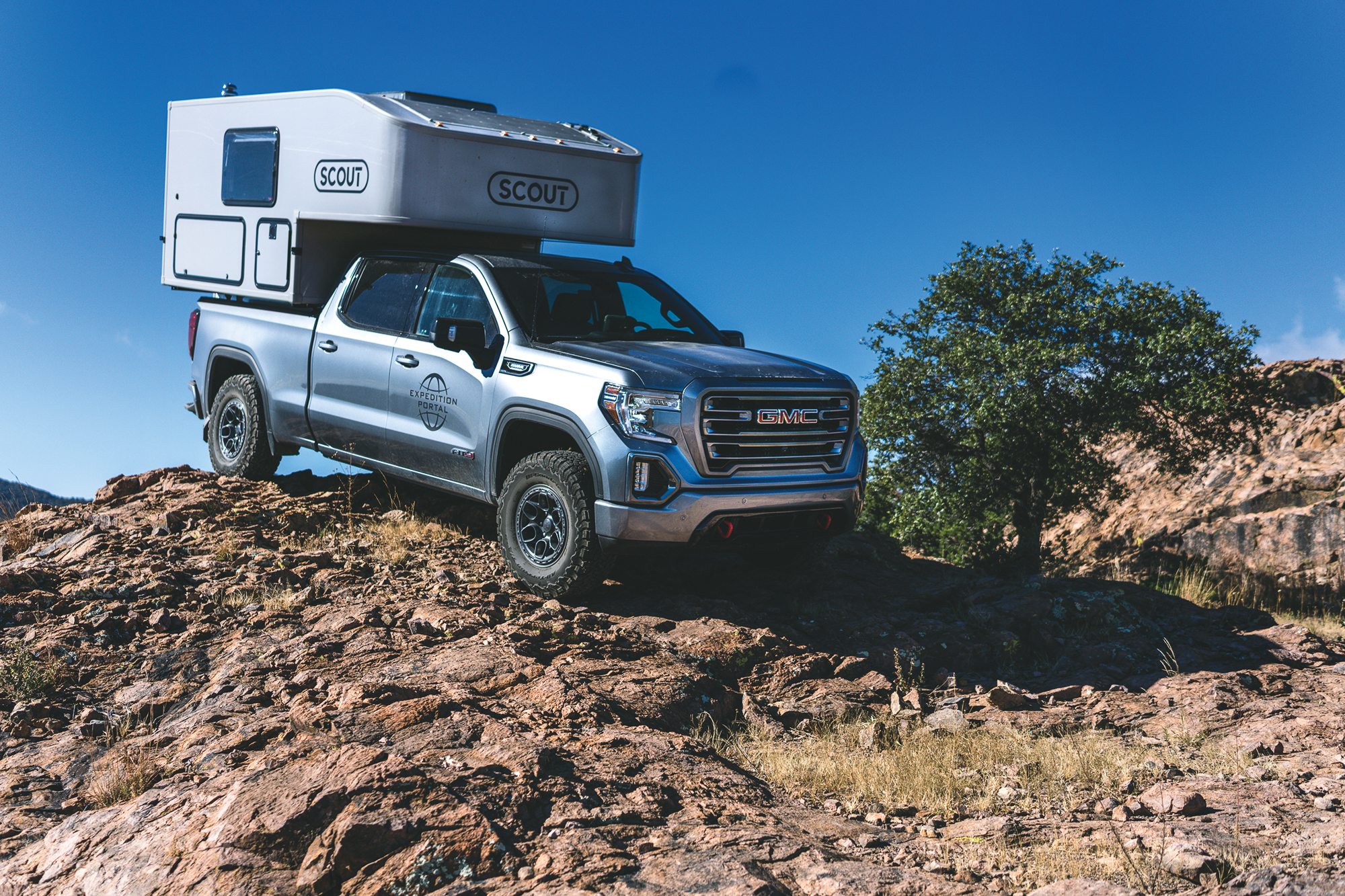Editor’s Note: This article was originally published in Overland Journal’s Gear 2022 Issue.
Times change. What was old is new, what was smaller is now bigger, and the lines blur within every automotive category. Travelers are finding the benefits of a slightly larger vehicle that is designed to carry heavy loads day in and day out. This is particularly true with full-size trucks, where a GMC Sierra gets better gas mileage than any mid-size truck, and a new Tacoma’s fuel consumption is nearly the same size as a first-generation Tundra. When we first started Overland Journal, the compact pickup was by far the most popular choice for overlanding, but that gap is quickly narrowing with full-size variants. The reason is simple—big trucks are more capable than ever before, and they have the payload to haul more than a few passengers and a basket of groceries.
Considerations
For this Overland Vehicle of the Year test, we are completing a comprehensive exploration of full-size offerings while emphasizing the attributes that most represent the segment. For an SUV test, it really is about balance of a broad range of functions; but with big trucks, it all comes down to moving weight competently across a wide range of surfaces. As a result, we have more heavily weighted scoring toward capacity and capability.
CAPACITY (Payload) A full-size truck needs to have an appropriate payload, allowing for the reserve capacity to fit overland campers, aftermarket accessories, racks, and supplies. We classify appropriate payload as 1,800 pounds or more for a light-duty full-size truck and 2,200 pounds or more for a heavy-duty full-size truck. Large trucks are also often called to tow heavier loads, like an off-road trailer or even an Airstream, so gross combined vehicle weight rating (GCVWR) is also a factor. Vehicles over gross vehicle weight rating (GVWR) can be subject to fines or even liability in an accident.
CAPABILITY Overland travel can involve changing weather (snow and mud), washed-out roads, sand dunes, and rocky trails. Having reserve capability allows the driver to explore with confidence and reduces the chance of getting stuck and missing that beautiful sunset. Capability reflects ground clearance, tire choice, articulation, traction (i.e., lockers, advanced traction control), and higher-speed dirt-road control.
RELIABILITY For remote, vehicle-based adventure travel, we need to be able to trust our vehicle to start and operate reliably in the field. All the capability and capacity in the world does little for us if the vehicle stops running. This attribute will be most important for those traveling the farthest afield and internationally and will be somewhat less critical for overlanders that tend to stay closer to home with a dealer infrastructure in place.
DURABILITY Durability is a measure of suitability to prolonged operation in abusive conditions: the construction of the frame, rating of the axles, quantity and strength of the skid plating, and so forth. While a Subaru Outback is extremely reliable, it will not endure backcountry abuse in the same way a Land Cruiser 79-Series pickup will.
RANGE/ECONOMY As overlanders, we often explore remote locations or drive long distances between refueling. The fuel economy of the drivetrain and the size of the fuel tank both contribute to the available range. Fuel economy can lower operating costs, which can allow for longer trips on a given budget.

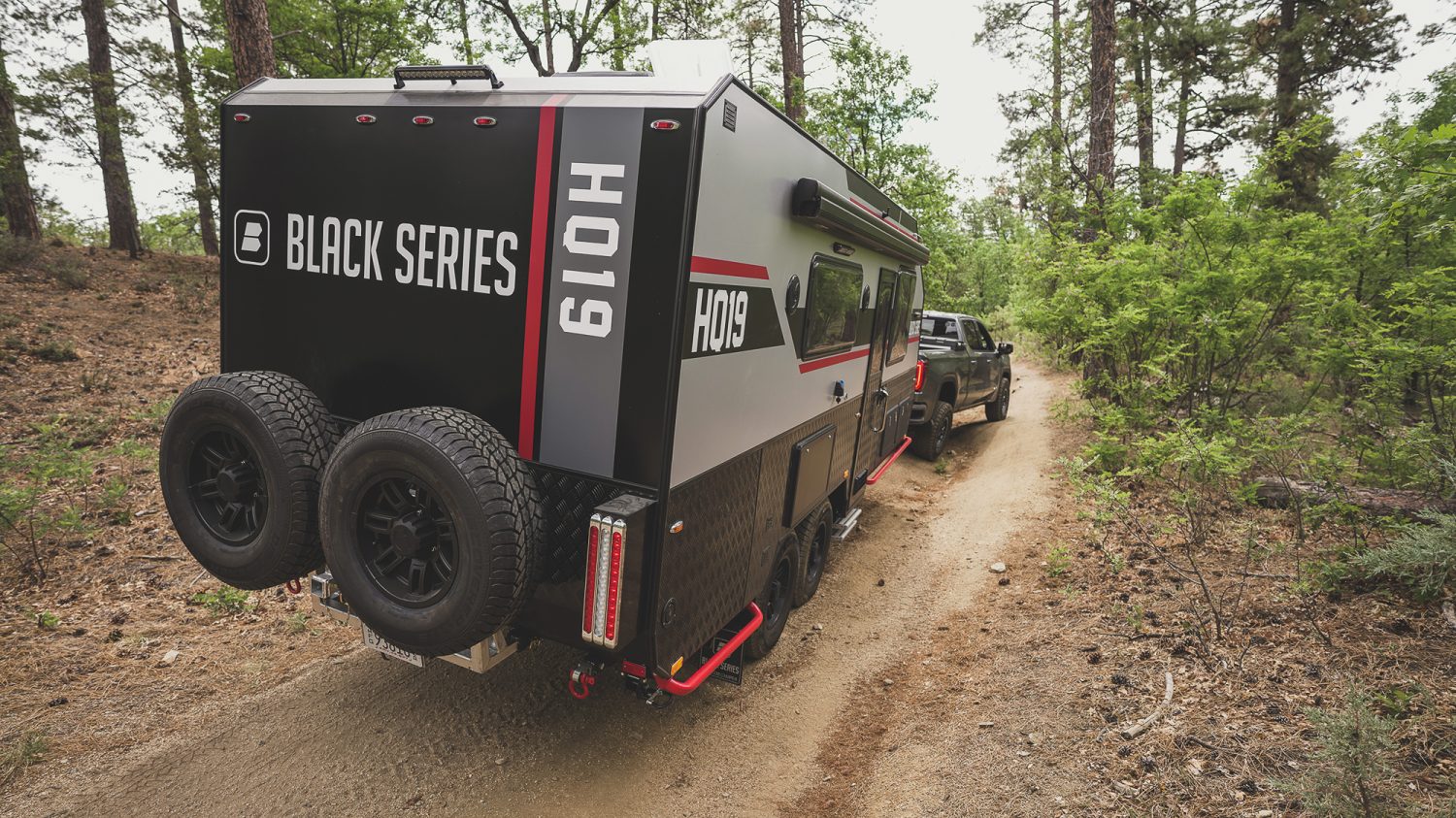
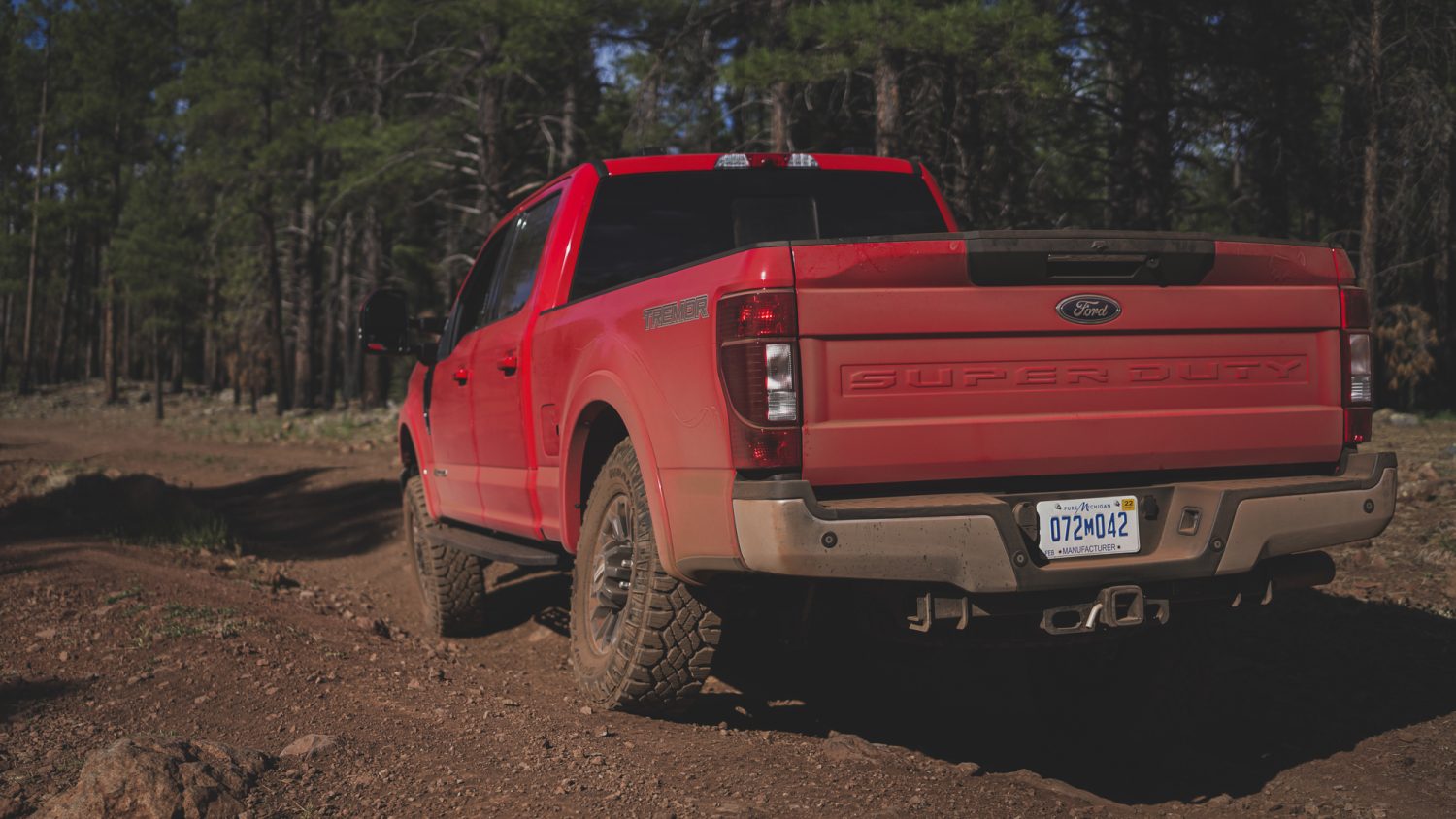
Reliability Ranking
Reliability is an essential consideration for backcountry travel, and within the full-size truck segment, there is limited distinction between the contenders. For example, the 2021 Ram wins the quality and reliability award from J.D. Power on heavy-duty trucks, but only two percent separates it from the Ford and the GMC. The reason for this is due to the high volume of these offerings and the emphasis OEMs are placing on reliability ranking. For light-duty full-size trucks, the Tundra remains the quality, durability, and reliability (QDR) champion, but that is not a direct correlation to the brand-new 2022 platform (which is likely to be reliable but is currently unproven). The Nissan Titan is only a few percentage points behind. Twenty years ago, the quality divide between a 4.7-liter Toyota Tundra and its competitors was a chasm. In 2022, initial quality and even reliability after three years of ownership represents nominal variation between manufacturers. When approaching a decade of ownership, QDR still favors Toyota and Nissan.
Vehicle Selection
One of the most challenging considerations for any test is selecting which makes and models arrive in the final lineup. Without question, this evaluation has been the most difficult, as there are so many quality options. For example, Ram makes the 2500/3500, the Power Wagon, and now the TRX. My initial conviction was to select only the 2500 diesel, but the Power Wagon is such a compelling and capable option (despite its payload of 1,561 pounds) that we elected to include both. The TRX and Raptor were not tested, as they do not meet our minimum full-size payload standard of 1,500 pounds. The minimum standard of 1,500 pounds should not be considered adequate for a full-size truck, but it does reflect the meager payloads manufacturers are engineering into their platforms. This test was restricted to 3/4-ton models (half-ton for the Tundra) due to their ideal compromise between ride quality and payload capacity. Some buyers may require a 1-ton variant, which will only be available from Ford, GMC, and Ram.
Payload Minimums by Classification:
- 1/2-ton pickup: 1,800 pounds minimum (2,200 pounds recommended)
- 3/4-ton pickup: 2,000 pounds minimum (3,000 pounds recommended)
- 1-ton pickup: 3,000 pounds minimum (3,500 pounds recommended)
The Benefits and Liabilities of Diesel Powertrains
While the diesel engine is a common power plant today, it did not gain widespread prominence until the fuel crisis of the 1970s. Benz & Cie produced the first diesel truck in 1923, and it was International Harvester, GMC, and Dodge that released diesel light trucks in the 1960s and 1970s, followed by Ford in 1983. Unfortunately, those early domestic offerings created a nefarious reputation for American diesel engines, a reliability scar that remained until the release of the 7.3-liter Ford. The 7.3 was co-developed with International Harvester and became the first reliable light-duty diesel sold in an American pickup. The Turtle Expedition famously drove theirs around the world trouble-free, including crossing Russia in winter.
Since that time, diesels have improved significantly in both power and efficiency. The first Ford 7.3-liter Power Stroke V8 made 210 horsepower and 425 pound-feet of torque. The current GMC Duramax 3.0-liter at only 40 percent the displacement of the 7.3 makes 277 horsepower and 460 pound-feet, all while delivering a best-in-segment 30 mpg. The current Power Stroke makes an unimaginable 1,050 pound-feet of torque. However, not all is perfect in diesel land. Buyers need to know that ultra-low-sulphur diesel has rolled out slowly in the developing world. Driving south of the US border can be done but with care. Many PEMEX stations sell ULSD (called Diesel Ultra Baja Azufre UBA), but only Costa Rica, Panama, and major Central American cities offer ULSD. If the goal is a circumnavigation of the Northern Hemisphere, you can drive from Prudhoe Bay, Alaska, to Magadan, Russia, on ULSD. As a result, know your intended route, as a gas variant may be a necessary power plant.
Testing
Five of the six vehicles were tested for weeks or sometimes months. Unfortunately, the timing of the article did not permit prolonged testing of the Toyota Tundra TRD Pro. Due to the Toyota being a brand-new model, Toyota did not have long-term loan units available, so our evaluation was completed near their San Antonio production facility during the comprehensive media launch. Fortunately, we did have enough time with it to perform our full spectrum of vehicle capability and dynamics evaluations. The half-ton Tundra was included in the review, as it is the only full-size truck model Toyota sells, and the model represents a significant percentage of our full-size truck readership.
Each model was subjected to a battery of tests, including a 96-point off-road and a 53-point on-road checksheet, a 38-point tire evaluation, and an 18-point overland-specific attribute scorecard. Inspection points include everything from the position of the ECU to the micro-keying attributes of the tires (measured by a durometer gauge).
Ford F-250 Tremor Power Stroke Turbo-diesel
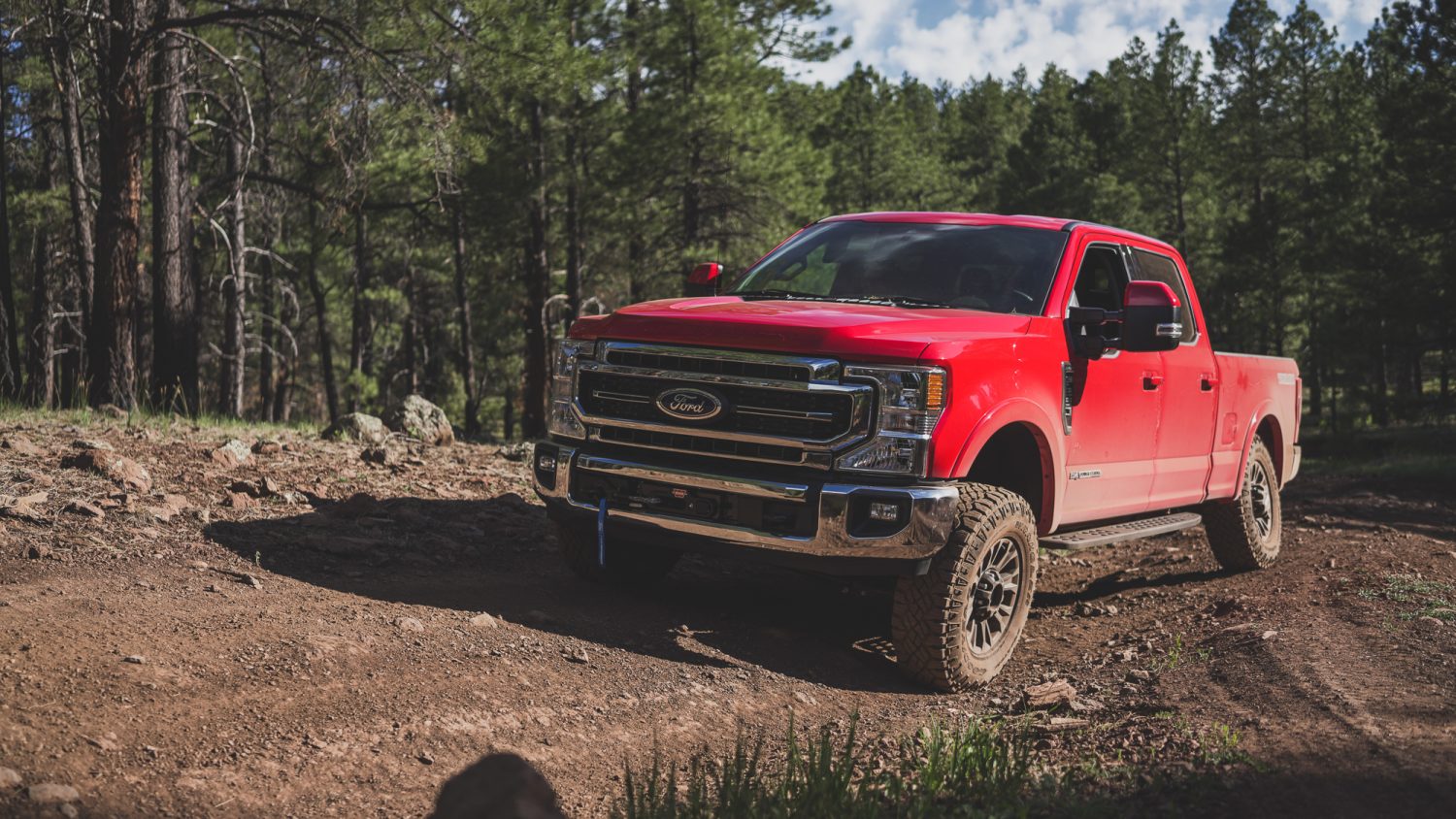
PAYLOAD, 2,665 pounds | $70,555
The Tremor is a powerhouse of torque, capacity, and capability.
Ford has the distinction of being North America’s first production pickup producer, selling the 1925 Model T Runabout. It was available with a factory-installed steel bed, including a fold-down tailgate, and the payload was an optimistic 2,000 pounds. Now, nearly 100 years later, Ford makes some of the most popular trucks produced today, including the new Tremor model we tested.
The Tremor package is notable among full-size pickups, as it has the primary attributes of capability and capacity. It is an overlander’s paragon from the front to the back with an available 12,000-pound Warn winch, high-clearance front bumper, mechanical limited-slip front differential, 2-inch factory lift, 35-inch Goodyear Duratrac tires, rock slider steps, and a rear locking differential. It would be impressive to stop there, but the Tremor gets even better with raised differential breathers, rock crawl trail control, and the available 6.7-liter Power Stroke diesel that boasts an impossible 1,050 pound-feet of torque.
Off-road, the Tremor is exceedingly surefooted, benefiting from the aggressive tires, locking rear differential, and limited-slip front differential. We searched for a scenario where the Tremor stumbled, but it climbed or crawled with ease anyplace it would fit. Climbing was particularly notable, the weight of the diesel engine (900+ pounds) and Warn winch (133 pounds) over the front axle, reducing hop and increasing vertical load force to the front tires. Rear articulation is good, but the front is limited by the heavy anti-sway bar and lack of disconnect. Throttle modulation and overall controls are well matched and make it easy to provide precise inputs as a driver. The one critical note on off-road performance is ride quality, which can only be described as unbearable without a load. In a 3/4- or 1-ton truck, we expect the ride quality to be stiff when unloaded, but usually only from the rear axle. In the case of the Tremor, the front is equally abusive, even with the heavy engine and winch. Airing down the tires helped, but this truck should only be considered with a camper or comprehensive buildout.
On longer trips, I found the drivetrain to be both smooth and exceedingly effective, providing prodigious torque in any gear at any speed. Without traction control, the Goodyears wouldn’t last a week. Anecdotally, I turned the traction control off to assess performance, and the tires nearly melted off the rims—so flagitious. While not as luxurious as other models, the interior suits my taste well, supported by the large greenhouse of glass and the beneficially stylized dip of the side windows. The exterior styling is one of the most handsome of the test, featuring flat panels with tasteful angles and a balanced grill and lighting package.
Pros
- Optimal combination of capability and payload
- 35-inch tires, winch, and factory lift kit
- 1,050 pound-feet and 10-speed automatic
Cons
- Only available in a crew cab with 6-foot bed
- Brutal ride quality when unloaded
- Would greatly benefit from the Bronco sway bar disconnect technology
Editor’s Preferred Configuration
F-250 Lariat Turbo-diesel with 6.7-liter Power Stroke and Tremor package
GMC Sierra 2500HD AT4 Duramax Turbo-diesel
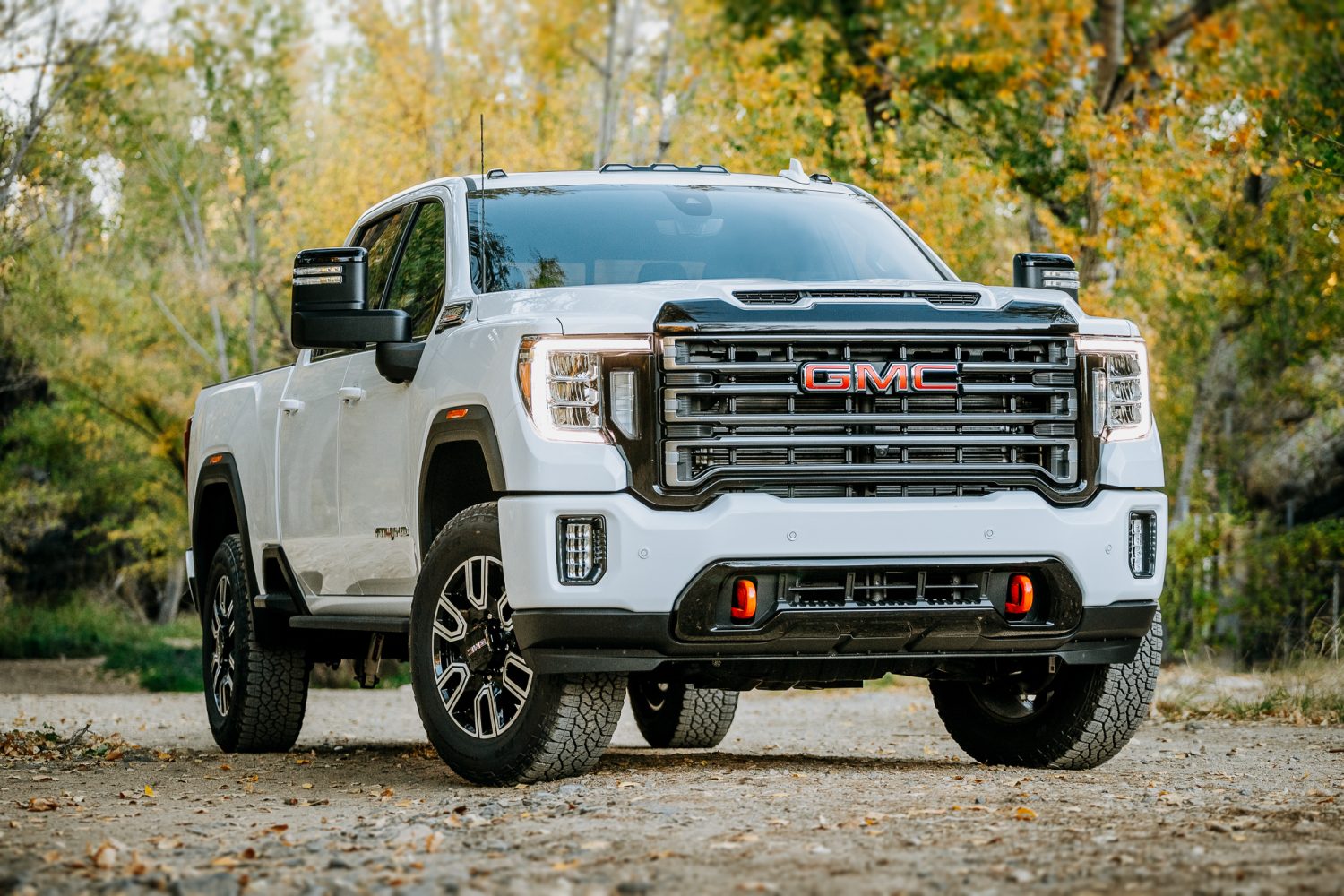
PAYLOAD, 3,563 pounds | $71,610
The optimal combination of comfort and capacity.
The GMC truck brand has a rich history in pickups, dating back to 1909, when General Motors Corporation purchased the Rapid and Reliance motor companies, officially changing the name to GMC in 1912. Overlanding was also a rich part of the early company, including the first motorized double crossing of the North American continent in 1916 with a 1.5-ton GMC truck.
With the 2019 model year, GMC launched their AT4 (All-terrain 4WD) performance package, which has grown from the Sierra to include the Yukon, Terrain, Acadia, Canyon, and the Sierra HD. For this comparison, we selected the Sierra HD with the 6.6-liter Duramax turbo-diesel and the AT4 off-road package. The AT4 model comes equipped with a G80 automatic rear locking differential, 18-inch wheels, all-terrain tires, additional skid plates, Rancho shocks, off-road terrain modes, and GVWR recovery points. The 4WD system is their two-speed AutoTrac transfer case with 2H, 4H, 4H automatic, and 4L.
For the trail, the ride quality of the GMC is immediately apparent, the benefit of the independent front suspension and premium passenger isolation. While the AT4 offers less articulation when compared to most in this test, it makes up for it in compliance on trails typically driven with a heavy-duty pickup. The crawl ratio of over 40:1 provides for excellent slow-speed control, complemented by the multiple exterior cameras and large greenhouse of glass. Additional care on the trail is required due to the reduced approach and breakover angles when compared with others reviewed here. Traction effectiveness is also lower than average, with the traction control allowing excessive wheelspin and the mechanical locker being slow or intermittent to engage. The combination of lower traction effectiveness and shallower off-road angles makes managing technical terrain more challenging. The HD would also greatly benefit from the more aggressive Goodyear Wrangler DuraTrac tire that is fit to the 1500.
During overland travel, there are features of the GMC that stand out, including the overall passenger space and comfort. The AT4 is just a nice vehicle to spend time in, with a quiet interior and ease of driving that reduces driver fatigue. This experience is enriched by the excellent multi-color heads-up display, which improves driver concentration and helps off-highway with pitch, roll, and tire position indicators. When packing the HD, it benefits from one of the most voluminous beds in the review, taking full use of the best payload in the models tested. Fitting a slide-in overland camper immediately comes to mind for this truck, which can handle the weight but also provide surefooted handling at speed due to the IFS. I have become a big fan of the MultiPro tailgates, which are easy to operate and make it so simple to climb up into the bed. The only downside is that removing the tailgate disables the rest of the generous 360 camera system. The 2500 HD is a true heavy hauler, giving excellent driver confidence in all mid- to high-speed conditions on-road and off.
Pros
- Payload king for a 2500
- Good ride quality given the payload
- Large bed capacity
Cons
- Lack of driver-selectable rear locker
- Wheel opening shape complicates larger tire fitment
Editor’s Preferred Configuration
2500 HD AT4 with Duramax turbo-diesel, Allison transmission, and driver assistance package
Editor’s Note: Due to chip shortages, we were only able to test drive the gasoline version (insights reflected here) of the AT, but have a diesel model en route for evaluation. The review will be updated to reflect the diesel model on expeditionportal.com.
Nissan Titan XD Pro-4X

PAYLOAD, 2,112 pounds | $57,045
The most heavy-duty and payload capable import.
Nissan has always focused on the union of capability, durability, and reliability, attributes most notably displayed in their legendary GU Patrol. That passion is evident within the truck division of Nissan USA, where a team of passionate overland enthusiasts has worked to build some of the most reliable pickups sold in North America. Nissan also produces a unique offering within this test, the Titan XD.
When the Titan first launched in 2005, Nissan sold an impressive 86,000 units. For 2015, the model became much more interesting for overlanders with the release of the A61 second-generation, available in both a standard half-ton and an XD model that made a 2,000-pound payload possible. Admirably, Nissan also made a 5.0 liter-Cummins turbo-diesel available, mated to an Aisin 6-speed automatic. I drove the diesel XD for several months and it was a joy to travel in. Unfortunately, the diesel was dropped in 2020 due to low consumer demand (we don’t get to keep nice things if we don’t support them). The year 2020 marked the most substantial refresh to the model in many years, with slight updates to the interior and exterior and the addition of a 400-horsepower V8.
Backcountry capability is supported by their Pro-4X package, which provides 32-inch General Grabber AT tires, multiple skid plates, Bilstein dampers, and most importantly, a locking rear differential. On the trail, the Titan is limited almost entirely by its poor overall clearance, including an approach angle of 21.1 degrees, breakover of 20.17, and minimum ground clearance of 8.8 inches (by comparison, a Subaru Forester, Wilderness model, has a 23.5-degree approach angle and 9.2 inches of ground clearance). The suspension exhibits minimal flex, resulting in reduced stability off-highway, and subsequently, lower driver confidence. The locking rear differential makes up for the loss of articulation and helps with the clearance issues, as the driver can maneuver through the terrain at slower speeds. The overall crawl ratio is also excellent at 60:1, which aids in low-speed control.
While traveling, the Nissan is a comfortable place to spend time, and there is a charm to its overall fitness to purpose. The ride quality is firm, reflecting the higher payload, but it is not jarring. The 5.6-liter V8 develops good power when prodded, but the standard ECU and shift mapping feels reluctant. Tow-haul mode helps that, and I found myself driving with it selected for any driving condition. The braking on the XD is excellent, benefiting from hydro assist and 14-inch discs in the front. The XD is a true heavy-duty variant, built on Nissan’s commercial chassis (fully boxed frame) with their larger rear axle. This results in a quality and reliable 3/4-ton truck that is ready to take the weight of an overland camper and explore the globe.
Pros
- 60:1 crawl ratio
- Locking rear differential
- 5 year/100,000-mile warranty
Cons
- Limited clearance restricts backroad travel
- Engine and transmission tuning feels sluggish
Editor’s Preferred Configuration
Titan XD Pro-4X with Convenience Package
Ram 2500 Tradesman Cummins Diesel (Value Award)
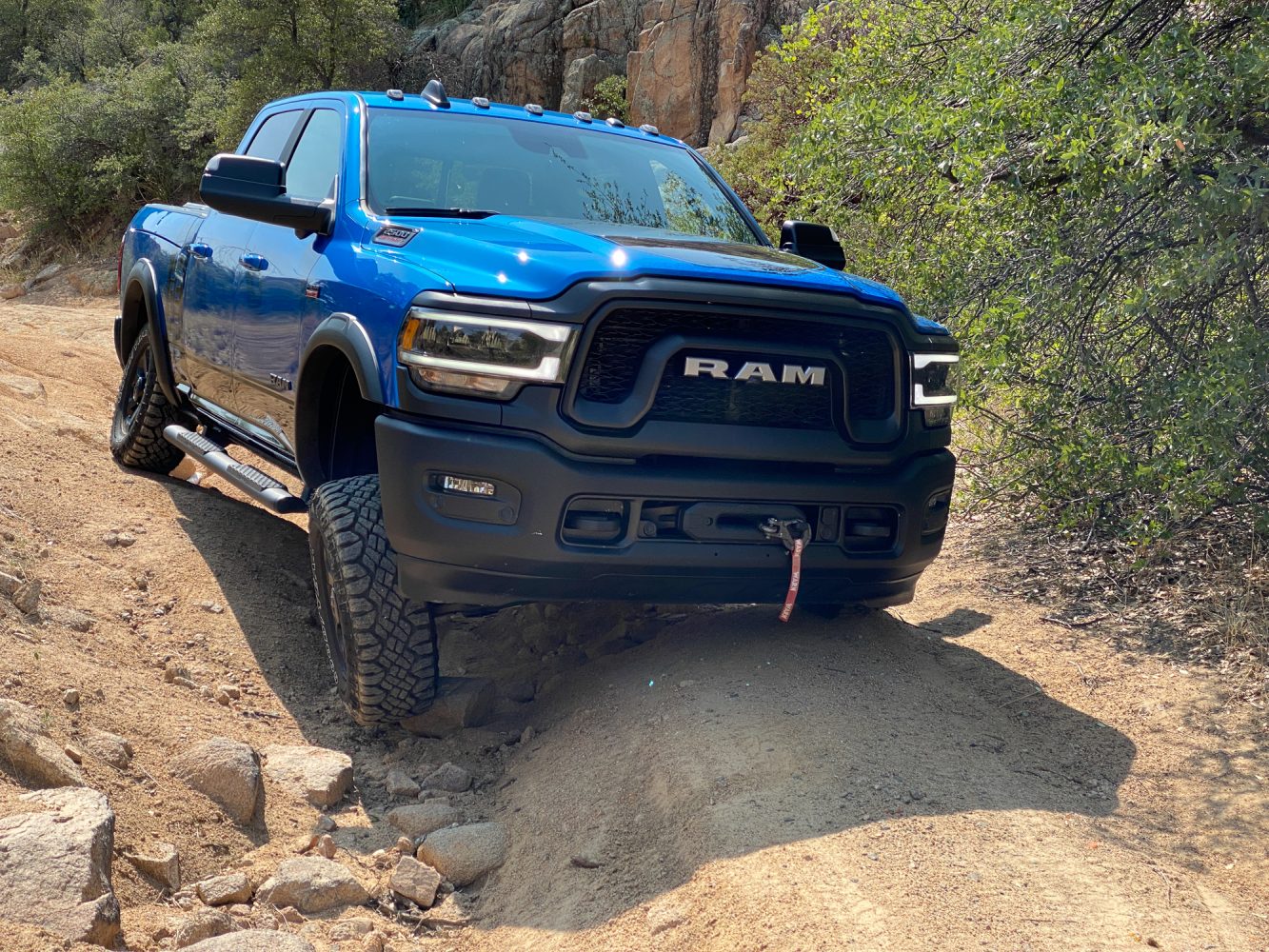
PAYLOAD, 2,490 pounds | $55,450
The heavy-duty Rams are the ideal canvas for customization.
The Dodge Brothers stepped onto the automotive scene under their own name in 1914; their lineup included a highly regarded panel van that became their commercial hauler. By 1921, the first Dodge trucks were on the roads (using Graham bodies), and by 1930, production was in full swing. With the conversion of their military trucks to the civilian market, Dodge also became the first to offer a factory 4WD pickup. From that point, their sales trailed the offerings from Ford and GMC until the release of the 1993 model with the Cummins turbo-diesel and significantly restyled front end. Sales increased by 400 percent over the previous model, and Ram has never looked back, topping 700,000 units in 2019.
While the Power Wagon gets all the off-road attention, the 2500 and 3500s have quietly overtaken the #1 seat in the full-size overland segment. With the combination of solid axles, the Cummins motor, and with the aftermarket support of companies like AEV, the Ram has consistently ranked as the most popular big truck for our audience (expeditionportal.com forum). The 2500 comes as either a coil-sprung multi-link or as an upgraded air suspension. Leaf springs are available on the 3500. The off-road package with a proper payload (i.e., non-Power Wagon) is limited, but it is possible to get an effective rear limited-slip that complements the brake traction control. The package includes hill-descent control, tow hooks, a transfer-case skid plate, Bilstein shocks, and all-terrain tires on 18-inch wheels. In stock form, the off-road performance of the Ram is in the middle of the pack, but the bones are really good, which makes it an ideal candidate for the aftermarket modifications.
Performance on the trail is more confidence-inspiring than the lack of a locker would suggest, as it has adequate trail angles, including a 23-degree approach angle and over 13 inches of ground clearance. Several trim levels also permit a manual shift of the transfer case, a piece of Luddite joy. Once in low range, the lack of low overall gearing is noticeable, particularly when descending or attempting to modulate power at the limits. The Ram is still capable of clearing the obstacles, but the combination of no locker and taller gearing lowers driver confidence. The suspension is an advantage in the other direction, with good rear travel and articulation, along with improved overall ride quality when compared with competitive 2500s.
On the road, the Ram is both comfortable and surefooted, with smooth power delivery from the Cummins turbo-diesel. Lightly loaded, acceleration is effortless, and the ride quality belies the model’s payload (which is not to say it isn’t on the firm side). The interior is also exceptional, particularly at the higher trims where the truck feels like a luxury SUV, supported by the comfortable seats and massive touch screen. Genuine leather and near-endless options are available, but I find the Tradesman to be the perfect balance of features and simplicity.
Pros
- Exceptional value even with the diesel powertrain
- Available with coil-sprung rear
- AEV Prospector aftermarket support enables Beast mode
Cons
- Lack of a locking rear differential option
- Six-speed automatic trails competitors
Editor’s Preferred Configuration
2500 Tradesman Regular Cab, 8-foot bed with Off-Road Package (2,810-pound payload)
Ram Power Wagon 75th Anniversary

PAYLOAD, 1,564 pounds | $69,890
The Power Wagon sets the standard for overland capability.
The 1946 Power Wagon was the first factory 4WD pickup sold to civilians and sustained a seven-decade run as one of the most capable pickups ever produced. The Power Wagon is, without question, the first full-size truck designed principally as a high-capability model, with both the pedigree and specification list to match.
To best relate the backcountry performance of the Power Wagon, it helps to list the off-road hardware, which reads like a dream. From the front, a high-clearance bumper houses a 12,000-pound Warn winch, and the actuator for the front sway bar disconnect. This disconnect permits full front axle articulation and a Ramp Travel Index (RTI) score of 655 (for reference, no other model in this test is even close). The front and rear axles are equipped with driver-selectable locking differentials, 17-inch wheels, and 33-inch Goodyear Wrangler tires. If the rear locker was not enough, the axle incorporates a helical-style limited slip and an effective traction control system. This is particularly useful on low traction surfaces like mud and snow, where a locked differential will exhibit undesirable under or oversteer. The old-school off-road joy continues into the interior with a manual transfer case shifter (tears of joy for that one). Even beadlock-capable wheels are an option.
Driving the Power Wagon on the trail is confidence-inspiring, with only the monstrous front clip giving the driver any pause. With the sway bar disconnected, I rarely needed the rear locker for our test tracks and only engaged the front to evaluate its ease of activation. The long-travel suspension does so much to vault driver confidence, keeping the hood completely flat and nearly eliminating uncomfortable head toss. Despite the 410 horsepower from the 6.4-liter V8, the throttle is easy to modulate through technical terrain and responds well to left-foot braking for even finer control. The only noticeable limitation is the overall wheelbase and dragging the heavily trussed 10.5-inch rear differential over various rocks and ruts.
For long-distance overlanding, the Ram interior is one of the best in the business, featuring premium materials and a large user interface screen. This permits Apple CarPlay to display Gaia and OnX on a massive scale, aiding navigation in the backcountry. All other driver inputs fall to hand easily, including the sway bar disconnect and front/rear locker buttons. The driving experience on the highway is stable until the limits, with the Goodyear tires squealing in protest before the chassis loses composure. Steering is not as direct as others in the test, but that is to be expected with a taller truck on large-diameter tires. Cruising is surprisingly comfortable, with the Power Wagon chewing up miles with nary any driver fatigue. The Power Wagon only finds its limits when adding payload, limiting it to a habitat-style camper or minimalist shell model. The original consumer 4×4 pickup retains its roots and remains one of the last greats of the internal combustion era.
Pros
- Class-leading capability
- Supremely comfortable cruiser
- $56,000 base price is a serious value
Cons
- Needs a max payload package of 2,000 pounds minimum
- Lowest fuel economy in the test due to lack of diesel power plant
Editor’s Preferred Configuration
Base model Power Wagon with the dual alternator package
Toyota Tundra SR5 TRD
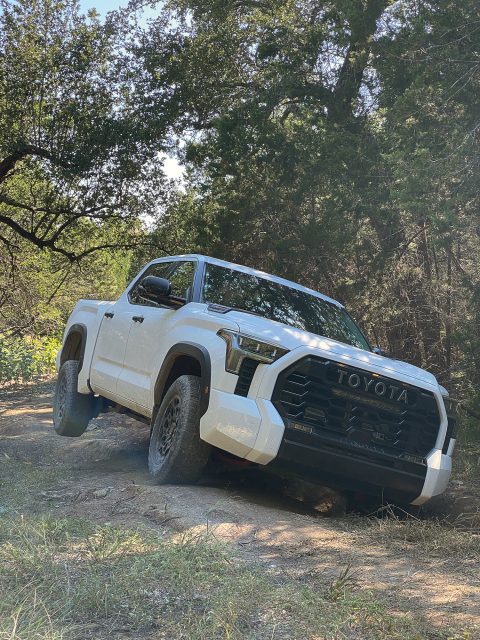
PAYLOAD, 1,885 pounds | $47,115
The newest Tundra has the heart and bones of a Land Cruiser.
Toyota trucks are legendary for their quality, durability, and reliability, with Tundras of any variant achieving million-mile service lives. The 2000-2006 model was one of my favorites, notable for its 7/8 full-size dimensions and nearly indestructible 4.7-liter V8. The launch of the 2000 Tundra was the most successful in Toyota history, with over 100,000 units sold. For the 2022 model year, Toyota has released an all-new Tundra to compete in the half-ton market, designed to be the most capable and overland-ready offering yet.
This newest Tundra has several important changes, including a chassis and engine shared with the new 300-Series Land Cruiser. The frame is fully boxed and precision reinforced to improve strength by 20 percent while reducing weight by 10 percent. The frame change also allowed converting from a leaf suspension to a five-link coil-sprung system (some models have optional air springs). The 3.5-liter V6 hybrid features twin-turbos and an inline electric motor/generator/starter that adds over 100 pound-feet of torque, making a combined 583 pound-feet at only 2,400 rpms.
While the model offerings seem simple on the surface, the Tundra needs to be equipped in a specific way to optimize capacity and capability. For example, the SR5 can be fitted with the TRD package (which includes a rear locker) and retain up to an 1,885-pound payload. The most capable model, the TRD Pro, has a payload set 285 pounds lighter at 1,600 pounds. If the goal is to install a lightweight camper, then the SR5 is key.
On the trail, the improved capability of the newest Tundra is immediately noticeable, for reasons both obvious and veiled. One of the significant issues with the outgoing model was the lack of a rear locker, but also the aggressive tip-in of the accelerator, making it a wheelspin king. Now, the SR5 can be equipped with the TRD package that includes a driver-selectable rear locking differential, but almost as important, it provides multi-terrain select, which has a rock crawling mode (in low range) that softens throttle responsiveness and also considerably improves traction control effectiveness. The improvement of technical terrain competence cannot be overstated. The one area we noted reduced capability was with articulation, which is surprising with the coil-sprung rear suspension. The reason for this is directly related to available shock length and shock position, as droop is limited by the damper stroke.
Once on the highway, the ride quality, power, and handling all come together, making the 2022 Tundra responsive and stable at speed. The roll center and anti-sway bar calibrations were properly tuned, providing a neutral and predictable chassis at the limits. Despite the improved handling, the ride is not busy or fatiguing. There is no question this is the most capable Tundra yet.
Pros
- Rear locking differential and multi-terrain select
- Best handling truck in the test
- Land Cruiser chassis and drivetrain (well, most of the drivetrain)
Cons
- Less rear axle articulation than outgoing model
- Lack of proper front recovery points
Editor’s Preferred Configuration:
TRD Pro DoubleCab 4WD with TRD Off-road package (provides an 1,810-pound payload)
Conclusions
It has been reassuring to see the growth of the full-size market within the overland community, as it demonstrates the increasing consumer awareness of payload capacity as a safety yardstick. The manufacturers are producing the most capable and durable full-size trucks in history, and even better ones are on the near horizon. As I write this, GMC has announced their Sierra AT4X, which is delivered with 33-inch tires and factory front and rear locking differentials. This will be a direct competitor to the Power Wagon and Tundra TRD Pro (with similar payloads). The success of the Tremor will force other manufacturers to consider capability right alongside capacity.
The Value Award goes to the Ram 2500, which provides the minimalism of the Tradesman package, but also includes the legendary Cummins diesel, a 5-link coil rear suspension, and a limited-slip rear differential. To purchase this configuration for less than $55,000 is reasonable in every regard. While this does not impact any testing results or awards, the Ram can be delivered directly to American Expedition Vehicles for their Prospector package, which would add another $20,200. That is only $4,000 more than a stock Tremor but would include 40-inch tires, a front bumper, heat reduction hood, suspension lift, new wheels, fenders, a snorkel, and 16,500-pound Warn winch.
For the Editor’s Choice Award, the decision came down to the Tremor, AT4, Power Wagon, and Tundra. The Tundra scored well in most of our capability tests and has the added benefit of legendary reliability. The Power Wagon performed best in all capability metrics, exceeding the Tremor due to the sway bar disconnect and front locking differential. In the end, the Tremor won the Editor’s Choice because it delivers on everything we need a full-size truck to be: capable and durable, with the payload to haul any reasonable overland load or camper. The Tremor’s capability is only eclipsed by the Power Wagon, but it is possible to specify an F-250 Tremor to have nearly three times the payload of the Power Wagon. The Tundra TRD Pro is arguably the best truck that Toyota has ever sold in North America, but the payload is still the limiting factor for serious full-size truck travel. Lastly, the GMC Sierra 2500HD AT4 is an impressive hauler, with the best payload for a 3/4-ton in the test, a locking rear differential, and the well-respected Duramax diesel. However, the AT4 lacks the ultimate trail capability of the Tremor. In the end, there is simply nothing like the Tremor on the market for overland travelers, but believe us when we say that even the 3/4 model requires a serious load (like a camper) to make the ride quality tolerable. There has been no better time to find the full-size overland truck of your dreams, packed with the capability and capacity for any adventure.
Other Considerations
GMC AT4 Sierra with 3.0-liter Turbo-diesel

PAYLOAD, 1,770 pounds | $55,140
The 3.0-liter straight-six turbo-diesel is one of the best motors available in a half-ton pickup and pairs with a 10-speed automatic to provide spirited performance (0-60 in 8 seconds) and 30 mpg fuel economy. It achieves 95 percent of the 460 pound-feet of torque at only 1,250 rpm, which makes trail work an easy proposition. Additional capability comes from the 2-inch factory lift, locking rear differential, and revised approach angle. Skid plates and Rancho shocks round out the package. It is pertinent to note that payload dissolves quickly when optioned up.
Hummer EV
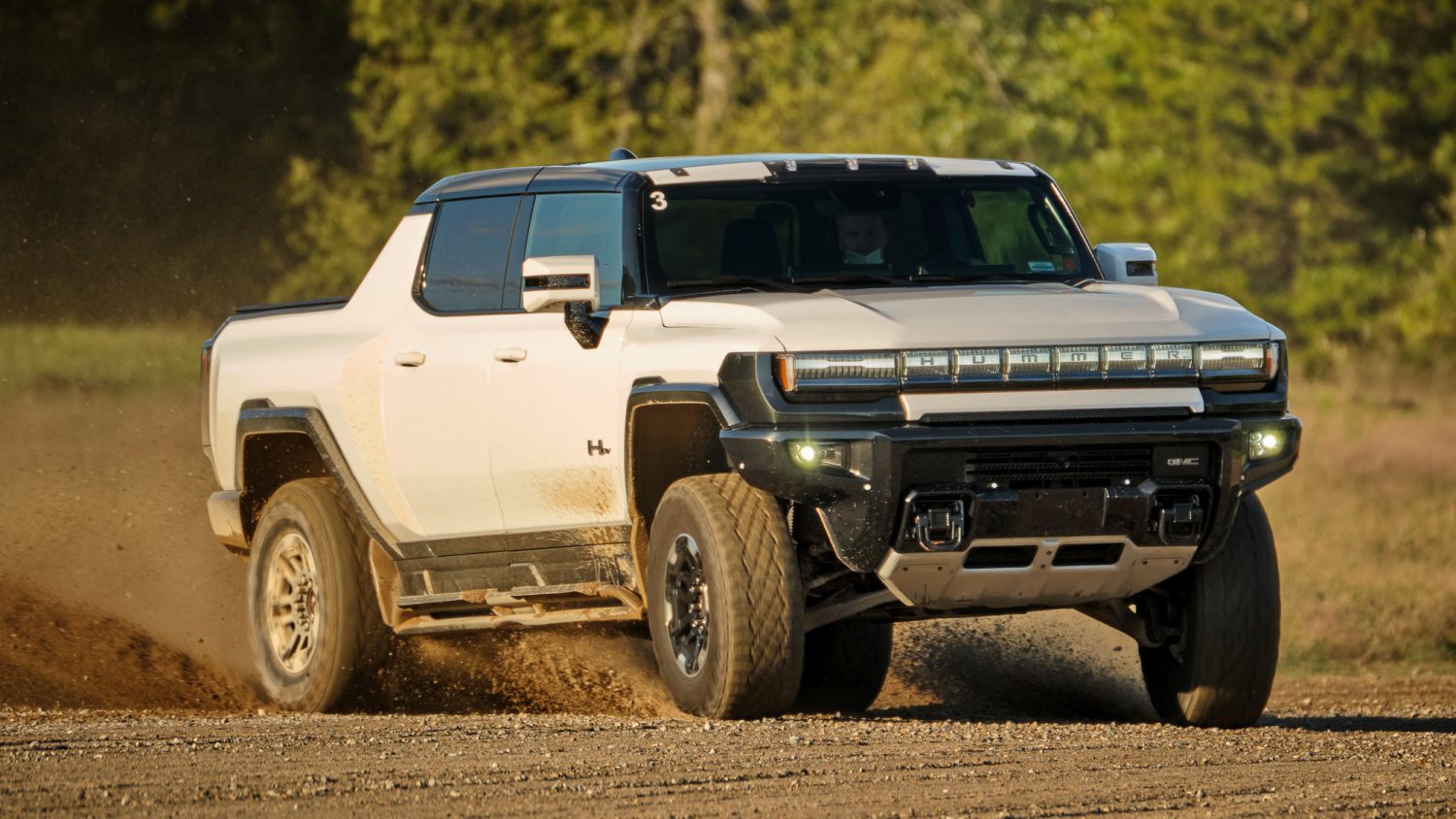
PAYLOAD, TBD | $112,000
Like the phoenix from the ashes, the HUMMER brand has been resurrected from the contentious brand of old, reimagined as an electric supertruck with 1,000 horsepower and 11,000 pound-feet of torque. Our first test of the EV can only be described as violently fast, impossibly surefooted, and impressively comfortable. Built on an independent front and rear airbag suspension with 35-inch tires (37s fit without modification), the supertruck floats across most terrain. When technical challenges arise, it can lift to 16 inches of ground clearance, seamlessly drive all four tires, and even crab crawl around rocks and ledges. Range is expected to be 350+ miles in mixed-road driving.
Ford F-150 4WD Regular Cab Long Bed EcoBoost
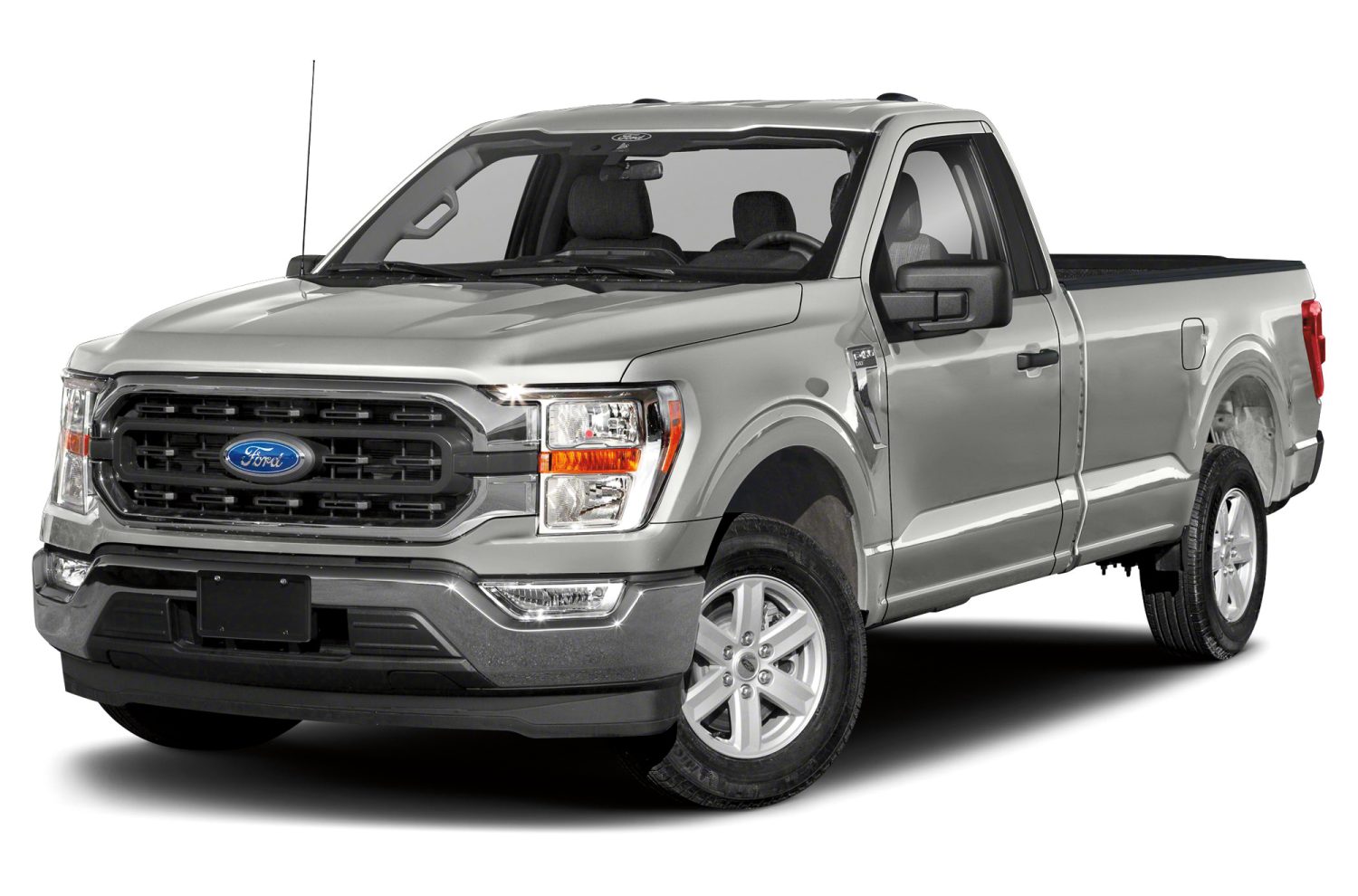
PAYLOAD, 3,035 | $44,030
Ford understands payload, with each of its models (including the Ranger) besting the competition handily. Of particular interest is the XLT regular cab with an 8-foot bed. This model provides a manageable 141-inch wheelbase, off-road package with a rear locking differential, low range transfer case, and an impossible 3,035-pound payload. Because of the popularity of the F-150, there is an endless number of aftermarket accessories to personalize the truck to the traveler’s needs, including nearly any of the overland campers (despite weight) on the market.
Our No Compromise Clause: We carefully screen all contributors to ensure they are independent and impartial. We never have and never will accept advertorial, and we do not allow advertising to influence our product or destination reviews.


